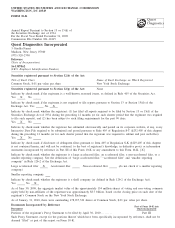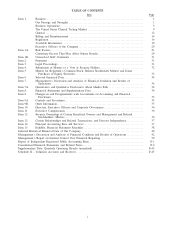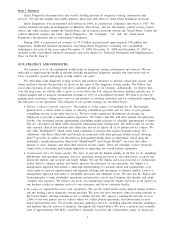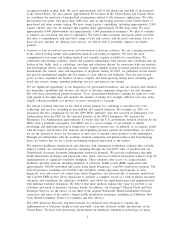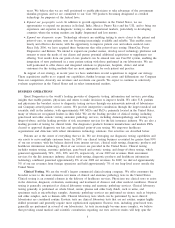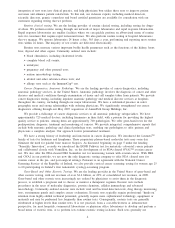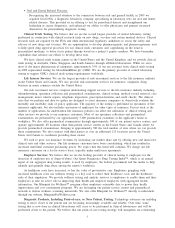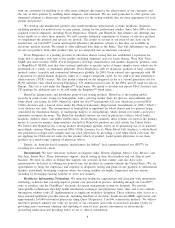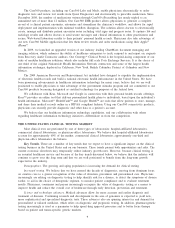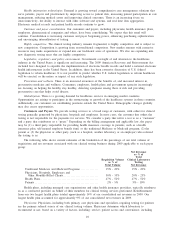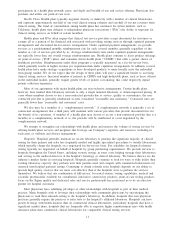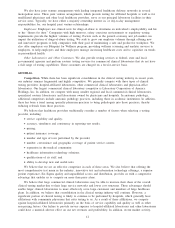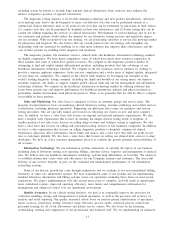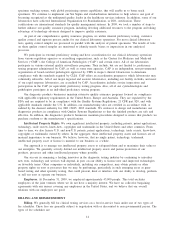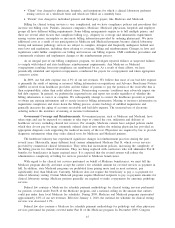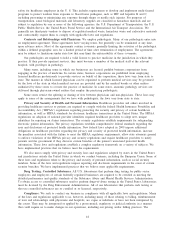Quest Diagnostics 2009 Annual Report Download - page 19
Download and view the complete annual report
Please find page 19 of the 2009 Quest Diagnostics annual report below. You can navigate through the pages in the report by either clicking on the pages listed below, or by using the keyword search tool below to find specific information within the annual report.The Care360 products, including our Care360 Labs and Meds, enable physicians electronically to order
diagnostic tests and review test results from Quest Diagnostics and electronically to prescribe medication. Since
December 2008, the number of medications written through Care360 ePrescribing has nearly tripled to an
annualized rate of more than 12 million. Our Care360 EHR product allows physicians to generate a complete
record of a clinical patient encounter, automates and streamlines the clinician’s workflow, and allows for rapid
deployment and implementation with minimal workflow disruption. The solution allows doctors to electronically
create, manage and distribute patient encounter notes including vital signs and progress notes. It captures lab and
radiology results and allows doctors to send secure messages and clinical information to other practitioners and
secure, Web-based laboratory results to their patients’ personal health records. Physicians also take advantage of
our new Care360 Mobile application that lets them review results and order medications using their Apple
iPhone.
In 2009, we launched an upgraded version of our industry leading ChartMaxx document managing and
imaging solution, which enhances the ability of healthcare enterprises to track, respond to and report on, requests
from Recovery Audit Contractor auditors. Our CentergyClinical Portal is the hospital-facing component of our
suite of modular healthcare solutions, which also includes full scale Data Exchange Services. It is the choice of
one third of the original Nationwide Health Information Network contractors and some of the largest health
information exchanges, deployed in California, New York, British Columbia, District of Columbia and New
Mexico.
The 2009 American Recovery and Reinvestment Act included laws designed to expedite the implementation
of electronic health records and build a national electronic health infrastructure in the United States. We have
been pioneering advancements in healthcare information technology for many years, believe that we are well
positioned to enable physicians to take advantage of the government stimulus program and are committed to our
Care360 products becoming designated as certified technology for purposes of the federal laws.
We collaborate with Keas, Microsoft and Google in connection with their personal health records offerings.
Keasprovides an online tool that delivers personalized health plans to individuals, based upon the individual’s
health information. MicrosoftHealthVaultand Google Healthare tools that allow patients to store, manage,
and share their medical records online in a HIPAA compliant fashion. Using our Care360 connectivity products,
physicians can securely provide diagnostic and other data to a patient’s account.
We believe that our healthcare information technology capabilities, and our collaboration with others
regarding healthcare information technology initiatives, differentiate us from the competition.
THE UNITED STATES CLINICAL TESTING MARKET
Most clinical tests are performed by one of three types of laboratories: hospital-affiliated laboratories;
commercial clinical laboratories; or physician-office laboratories. We believe that hospital-affiliated laboratories
account for approximately 60% of the market, commercial clinical laboratories approximately one-third and
physician-office laboratories the balance.
Key Trends. There are a number of key trends that we expect to have a significant impact on the clinical
testing business in the United States and on our business. These trends present both opportunities and risks. The
current economic slowdown may temporarily reduce industry growth rates. However, because clinical testing is
an essential healthcare service and because of the key trends discussed below, we believe that the industry will
continue to grow over the long term and that we are well positioned to benefit from the long-term growth
expected in the industry.
Demographics. The growing and aging population is increasing the demand for clinical testing.
Increased testing. We believe that we have entered the decade of diagnostics, moving from dominant focus
on curative care to a greater recognition of the value of detection, prevention and personalized care. Physicians
increasingly are relying on diagnostic testing to help identify risk for a disease, to detect the symptoms of disease
earlier, to aid in the choice of therapeutic regimen, to monitor patient compliance and to evaluate treatment
results. Physicians, consumers and payers increasingly recognize the value of diagnostic testing as a means to
improve health and reduce the overall cost of healthcare through early detection, prevention and treatment.
Science and technology advances. Medical advances allow for more accurate and earlier diagnosis and
treatment of diseases. Continuing research and development in the area of genomics is expected to yield new,
more sophisticated and specialized diagnostic tests. These advances also are spurring interest in and demand for
personalized or tailored medicine, which relies on diagnostic and prognostic testing. In addition, pharmacogenetic
testing increasingly is used as a parameter to help speed drug approval processes and to better focus therapy
based on patient and tumor-specific genetic markers.
9


